Superstition Mountains
| Superstition Wilderness | |
|---|---|
|
IUCN category Ib (wilderness area) | |
|
The Flat Iron peak | |
| Location | Maricopa / Pinal / Gila counties, Arizona, USA |
| Nearest city | Apache Junction, Arizona |
| Coordinates | 33°28′41″N 111°14′20″W / 33.47806°N 111.23889°WCoordinates: 33°28′41″N 111°14′20″W / 33.47806°N 111.23889°W |
| Area | 159,757 acres (64,651 ha) |
| Established | 1939 |
| Governing body | U.S. Forest Service |

The Superstition Mountains (Yavapai: Wi:kchsawa), popularly called "The Superstitions", are a range of mountains in Arizona located to the east of the Phoenix metropolitan area. They are anchored by Superstition Mountain, a large mountain that is a popular recreation destination for residents of the Phoenix, Arizona area.
The mountain range is in the federally designated Superstition Wilderness Area, and includes a variety of natural features in addition to its namesake mountain. Weavers Needle, a prominent landmark and rock climbing destination set behind and to the east of Superstition Mountain, is a tall eroded volcanic remnant[1] that plays a significant role in the legend of the Lost Dutchman's Gold Mine. Peralta Canyon, on the northeast side of Superstition Mountain, contains a popular trail that leads up to Fremont Saddle, which provides a very picturesque view of Weavers Needle. Miner's Needle is another prominent formation in the wilderness and a popular hiking destination.
As with most of the terrain surrounding the Phoenix metropolitan area, the Superstition Mountains have a desert climate, with high summer temperatures and a handful of perennial sources of water. The elevation in the more remote, eastern portion of the wilderness is higher than the western portion, which lowers temperatures slightly. Numerous hiking trails cross the mountains from multiple access points, including the Peralta Trailhead, the most popular.[2] The Lost Dutchman State Park, located on the west side of Superstition Mountain, includes several short walking trails.
The Superstition Mountains are bounded roughly by U.S. Route 60 on the south, State Route 88 on the northwest, and State Route 188 on the northeast.
The mountains were once known in Spanish as Sierra de la Espuma.
The Superstition Mountains have a maximum elevation of 6,266 ft (1,910 m) and prominence of 1,706 ft (520 m) at Mound Mountain in the far eastern section of the range.[3][4][5]
Superstition legends

The legend of the Lost Dutchman's Gold Mine centers around the Superstition Mountains. According to the legend, a German immigrant named Jacob Waltz discovered a mother lode of gold in the Superstition Wilderness and revealed its location on his deathbed in Phoenix in 1891 to Julia Thomas, a boarding-house owner who had taken care of him for many years. Several mines have been claimed to be the actual mine that Waltz discovered, but none of those claims have been verified.[1] The legends and lore of the Superstition Mountains can be experienced at the Superstition Mountain Museum on the Apache Trail where artifacts of the Lost Dutchman are on display.
Some Apaches believe that the hole leading down into the lower world, or hell, is located in the Superstition Mountains. Winds blowing from the hole are supposed to be the cause of severe dust storms in the metropolitan region.[6]
Nearby towns and cities

- Apache Junction, Arizona
- Tortilla Flat, Arizona
- Superior, Arizona
- Phoenix, Arizona
- Gold Canyon, Arizona
See also
- Legend of the Superstition Mountains a 2015 TV series with 6 episodes on History Channel about people looking for gold in the area
- List of U.S. Wilderness Areas
- List of Arizona Wilderness Areas
- List of mountain ranges of Arizona
- Wilderness Act
References
- 1 2 Kollenborn, Tom (1990). "Weaver's Needle or Picacho?". Archived from the original on 2004-10-30. Retrieved April 1, 2007.
- ↑ Carroll, Doug. "Hiking the Supsertitions". Retrieved April 1, 2007.
- ↑ "Mound Mountain, East Superstition Mountains". peakbagger.com. Retrieved 2016-09-02.
- ↑ "East Superstition Mountains". peakbagger.com. Retrieved 2016-09-02.
- ↑ "Superstition Mountains Benchmark, Western section". peakbagger.com. Retrieved 2016-09-02.
- ↑ Vitaliano, Dorothy. 1973. Legends of the Earth, Bloomington: University of Indiana Press, pp. 170-171.
External links
| Wikimedia Commons has media related to Superstition Mountains. |
- HikeArizona.com: Numbered Trails Map
- Official Apache Trail website: Superstition Mountains
- Tonto National Forest: Superstition Wilderness Area
- Wilderness.net: Superstition Wilderness Area
- GORP.com: Superstition Wilderness
- Ajpl.org: History of the Superstitions
- JustRoughinIt.com: Superstition Wilderness Average Climate
